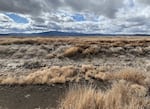
FILE: The parched Lower Klamath National Wildlife Refuge pictured in October 2021.
Erik Neumann / JPR News
The U.S. Department of the Interior announced more than $72 million for the Klamath Basin on Wednesday.
The funding from the federal Bipartisan Infrastructure Law and Inflation Reduction Act is aimed at ecosystem restoration and agricultural infrastructure modernization.
The investment was announced in conjunction with a new memorandum of understanding signed by representatives from the Klamath, Yurok and Karuk tribes and the farming group Klamath Water Users Association. According to an Interior Department official, the agreement marks a level of cooperation between these groups that hasn’t been seen in a decade.
“Following months of consultation and discussions, we’re proud to formalize this partnership with Tribes and irrigators and make a shared commitment that will benefit the forests, watersheds, agriculture and abundant populations of migratory bird and fish species that are unique to this Basin,” wrote Interior Secretary Deb Haaland in a press statement.
The MOU says the groups will work together to identify restoration goals to improve water supply reliability for “ecosystem resilience, fish populations and wildlife refuges, and irrigation.”
With regular drought tightening demand, competition over water is an annual problem between farmers, tribes seeking to protect endangered and threatened fish species and the basin’s six national wildlife refuges that are major stopover points for migratory birds.
Despite the competition, money is one way to bring opposing parties to the table.
The full $72.7 million is broken down into $64 million “to restore the regional ecosystem and repair local economies.” This allocation will fully fund the Klamath Falls National Fish Hatchery by 2027. The hatchery is used to rear endangered sucker fish that are culturally significant to the Klamath Tribes. Also Included in the $64 million is $25 million for collaborative conservation efforts in the basin.
“By agreeing to common objectives and shared goals for the Klamath Basin restoration, we can move forward together — as a unified front — to secure critical funding needed for our region,” said Paul Simmons, executive director of KWUA in a statement. “This cohesiveness creates a better chance for our projects to catch eyes at the federal and state levels and receive funding.”
Four million dollars will be used to support the 14,000-acre Agency-Barnes wetland restoration project at the Upper Klamath National Wildlife Refuge. The project will reconnect two units of Upper Klamath Lake to increase water storage and wetland habitat for migratory waterfowl and fish passage.
Another $1.8 million will be used for a feasibility analysis of modifications to water supply infrastructure for the Klamath Drainage District. A final $2.9 million will go to the Klamath Tribes, Yurok Tribe, Hoopa Valley Tribe, Karuk Tribe and Modoc Nation for projects to restore wetlands.
According to the MOU, within 30 days the tribes and KWUA will meet to identify specific restoration projects that could be completed within 1-2 years with federal and state funding. Within 60 days they’ll submit priority restoration projects to the Interior Department.